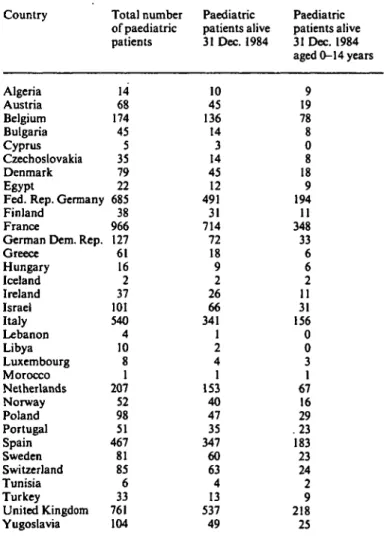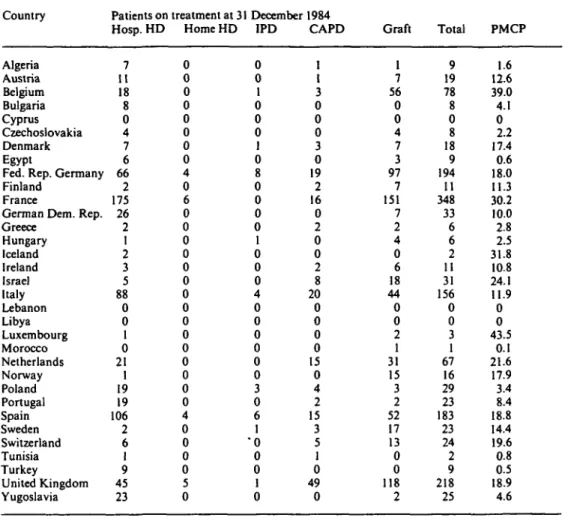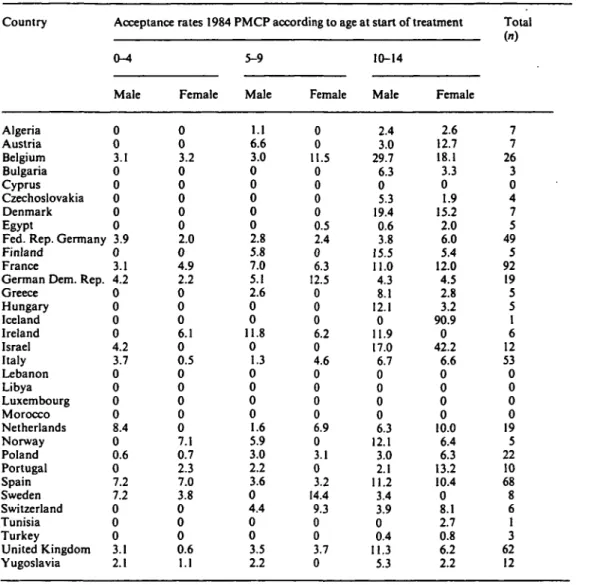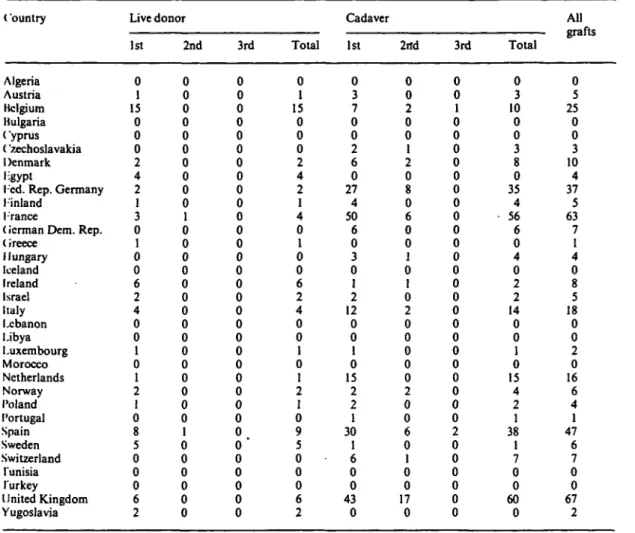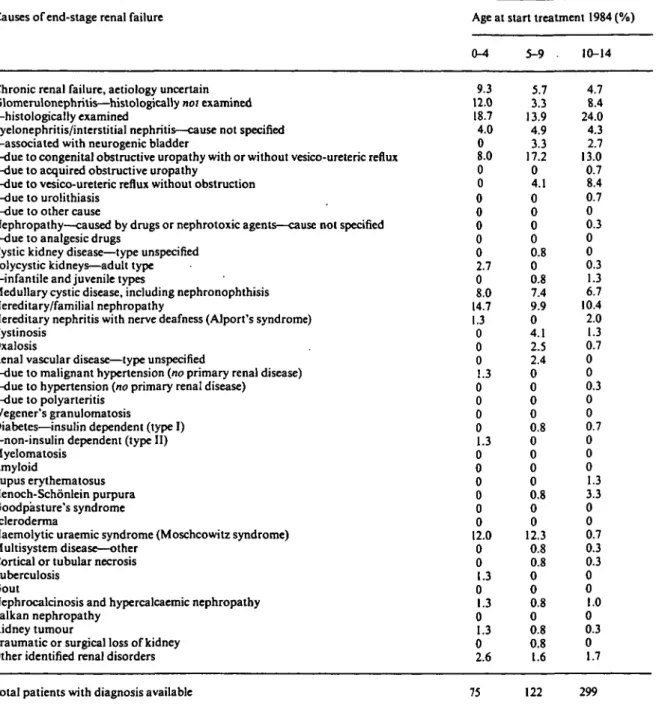Nephrology
Dialysis
Transplantation
Registry Report
Demography of Dialysis and Transplantation in Children in Europe, 1984
Report from the European Dialysis and Transplant Association Registry*
"Members of the Registration CommitteeM. Broyer Hopital Necker Enfants Malades, Paris, France
F. P. Brunner** Department fur Innere Medizin, Universitat Basel, Switzerland H. Brynger Department of Surgery I, Sahlgrenska
Sjukhuset, Goteborg, Sweden W. Fassbinder Klinikum der Johann Wolfgang
Goethe-Universitat, Frankfurt am Main, Federal Republic of Germany
University Department of Surgery, St James's Hospital, Leeds, United Kingdom Centre Hospitalier Regional et
Universitaire de Nimes, France P. J. Guillou R. Oules ••Chairman G. Rizzoni N. H. Selwood A. J. Wing Director S. Challah
Clinica Pediatrica dell'Universita, Ospedale Civile di Padova, Italy UK Transplant Service, Bristol, United Kingdom
St Thomas' Hospital, London, United Kingdom
St Thomas' Hospital, London, United Kingdom
Assistant to Chairman
S. R. Dykes St Thomas' Hospital, London, United Kingdom
Abstract. The demography of treatment of children by renal replacement therapy in Europe is presented based on returns of individual patient questionnaires to the EDTA Registry up until the close of 1984. Patient questionnaires for 1984 were completed by all centres which defined them-selves as special paediatric units. A total of 4983 patients have been reported to the Registry up until 31 December 1984 as having commenced renal replacement therapy under the age of 15. Of these, 1570 were known to be alive on a defined form of treatment at the end of 1984 and still under the age of 15. The numbers of these patients kept alive by different forms of treatment in individual countries are presented. The stock of patients aged under 15 at the end of 1984 exceeded 30 per million child population in Belgium, France, Iceland and Luxembourg. The highest age specific acceptance rates for children onto renal replace-ment therapy during 1984 were noted in those aged between
10 and 14 at first treatment. Age specific acceptance rates for children varied greatly between individual countries, and 18 countries reported no new patients under the age of 5 during 1984. Transplant activity in paediatric patients during 1984 has been analysed and results on regrafting pre-sented. Proportional distribution of primary renal diseases amongst children commencing therapy in 1984 is shown according to age at start of treatment. Haemolytic uraemic syndrome was reported as the cause of end-stage renal failure in 12.0% of children commencing treatment under the age of 5, and 12.3% of children between 5 and 9. Finally, information on cause of death in paediatric patients dying during 1984 is presented, and shows cardiovascular disease was the leading cause of mortality.
Key words: Chronic renal failure; Haemodialysis; Trans-plantation; CAPD; Demography
Correspondence and offprint requests to: Dr F. P. Brunner, European
Dialy-sis and Transplant Association Registry, St Thomas' Hospital, London SE1 7EH, England.
© 1986 European Dialysis and Transplant Association-European Renal Association
10
Introduction
The Registry of the European Dialysis and Transplant Association—European Renal Association (EDTA Registry) has regularly presented data on children treated by renal replacement therapy since 1972 and has published a series of 14 Combined Reports on Regular Dialysis and Transplantation in Children in Europe in the Proceedings of the EDTA-ERA. The last of these appeared in 1985 [1].
This report on treatment of children, the first to be pre-pared by the Registry for the new journal, is based exclus-ively on data provided on individual patient questionnaires and relates to treatment up until 31 December 1984. Ana-lyses were carried out on the Registry's files at the time of the preprinting of the 1985 questionnaires, the point in the Registry's annual cycle when the data base is in its best form.
paediatric centres. Patient questionnaires for 1984 were returned by all of these 97 units.
Up to 31 December 1984, 4983 patients were reported to the Registry as having commenced renal replacement therapy under the age of 15. Of these, 3405 were alive on a known method of treatment and 1570 were under the age of 15 (Table 1).
Table 2 shows the stock of patients aged under 15 on 31 December 1984, alive on a known form of renal replace-ment therapy. Both absolute numbers and total per million child population (PMCP) are given. Data on child popu-lation were obtained from the WHO Statistics Annual using the most up to date information available for each country.
Age and sex specific acceptance rates for children onto renal replacement therapy in 1984 are given by country in Table 3. An age-sex specific rate is calculated by dividing the number of new patients in each age and sex category by the total number of children in the general population of the
Methods: the Paediatric Registry data base
All patients who commence renal replacement therapy under the age of 15 are defined as paediatric. In the year of any particular report, many of these will have reached adult age, and so the word 'children' has been adopted to describe patients who commence therapy under 15 and who are still under that age on 31 December in the year under consideration.
Patient questionnaires completed on children are handled in the same way as those for adults, and the Registry's main patient file contains data on all individually registered patients irrespective of age at start of treatment. The infor-mation collected and the method of handling forms and notification of new centres are described in the preceding paper. A distinction between children and adult patients is only made at the time analyses are carried out. A special paediatric file has been created to link data from individual patient questionnaires on children to those obtained from the special paediatric enquiry which goes out to selected centres each year. Information from the special file is not included in this report.
Results: demographic statistics
Children may be treated in either non-specialised or specialised paediatric centres. These are self-defined on the Registry's centre questionnaire. The completeness of the paediatric survey for 1984 may be assessed from Table 1 of the general demographic article which precedes this. This shows the total number of centres known in countries reporting to the Registry and the proportion which returned patient questionnaires for 1984. In the 1984 centre questionnaire, 97 units defined themselves as specialised
Table 1. Summary of patients reported to the Registry who commenced renal replacement therapy under 15 years of age. Total number, number alive at the end of 1984, and number known to be alive at the end of 1984 still aged under IS are given
Country Algeria Austria Belgium Bulgaria Cyprus Czechoslovakia Denmark Egypt
Fed. Rep. Germany Finland
France
German Dem. Rep. Greece Hungary Iceland Ireland Israel Italy Lebanon Libya Luxembourg Morocco Netherlands Norway Poland Portugal Spain Sweden Switzerland Tunisia Turkey United Kingdom Yugoslavia Total number of paediatric patients 14 68 174 45 5 35 79 22 685 38 966 127 61 16 2 37 101 540 4 10 8 1 207 52 98 51 467 81 85 6 33 761 104 Paediatric patients alive 31 Dec. 1984 10 45 136 14 3 14 45 12 491 31 714 72 18 9 2 26 66 341 1 2 4 1 153 40 47 35 347 60 63 4 13 537 49 Paediatric patients alive 31 Dec. 1984 aged 0-14 years 9 19 78 8 0 8 18 9 194 11 348 33 6 6 2 11 31 156 0 0 3 1 67 16 29 .23 183 23 24 2 9 218 25
Table 2. Stock of children alive on 31 December 1984 in individual countries. Numbers on different forms of renal replacement therapy given together with the total number per million child population (PMCP) Country Algeria Austria Belgium Bulgaria Cyprus Czechoslovakia Denmark Egypt
Fed. Rep. Germany Finland
France
German Dem. Rep. Greece Hungary Iceland Ireland Israel Italy Lebanon Libya Luxembourg Morocco Netherlands Norway Poland Portugal Spain Sweden Switzerland Tunisia Turkey United Kingdom Yugoslavia Patients on Hosp. HD 7 11 18 8 0 4 7 6 66 2 175 26 2 1 2 3 5 88 0 0 1 0 21 1 19 19 106 2 6 1 9 45 23 treatment at 31 Home HD 0 0 0 0 0 0 0 0 4 0 6 0 0 0 0 0 0 0 0 0 0 0 0 0 0 0 4 0 0 0 0 5 0 December IPD 0 0 1 0 0 0 1 0 8 0 0 0 0 1 0 0 0 4 0 0 0 0 0 0 3 0 6 1 "0 0 0 1 0 1984 CAPD 1 1 3 0 0 0 3 0 19 2 16 0 2 0 0 2 8 20 0 0 0 0 15 0 4 2 15 3 5 1 0 49 0 Graft 1 7 56 0 0 4 7 3 97 7 151 7 2 4 0 6 18 44 0 0 2 1 31 15 3 2 52 17 13 0 0 118 2 Total 9 19 78 8 0 8 18 9 194 11 348 33 6 6 2 11 31 156 0 0 3 1 67 16 29 23 183 23 24 2 9 218 25 PMCP 1.6 12.6 39.0 4.1 0 2.2 17.4 0.6 18.0 11.3 30.2 10.0 2.8 2.5 31.8 10.8 24.1 11.9 0 0 43.5 0.1 21.6 17.9 3.4 8.4 18.8 14.4 19.6 0.8 0.5 18.9 4.6
same age and sex. The data are given for three age groups, those aged between 0 and 4 years at first treatment, those aged 5-9, and finally, those aged 10-14. Acceptance rates are shown separately for males and females in each age category. The table also gives the total number of children who commenced replacement therapy in 1984. This figure will include children whose sex was not registered. There were a total of 522 new paediatric patients in 1984.
Transplantation activity during 1984 in children is summarised in Table 4. This divides the grafts according to source, live donor or cadaver, and shows the numbers which were first, second or third grafts. A total of 353 grafts in children were reported in 1984. Table 4 shows the graft according to the country where the child was last registered. This does not necessarily indicate where the transplant was performed.
The proportional distribution of primary renal diseases leading to end-stage renal failure amongst children com-mencing renal replacement therapy in 1984 is given in Table 5. The results are shown according to age at start of treatment for three age categories. Among 75 children
who commenced treatment under the age of 5 in 1984, glomerulonephritis was the most common primary renal disease diagnosed. Haemolytic uraemic syndrome accounted for a further 12.0% of primary renal diseases in this age group. In children aged 5-9 years at first treatment, glomerulonephritis accounted for 17.2% of primary renal diseases, whereas pyelonephritis/interstitial nephritis was the diagnosis in just over a quarter of cases. Haemolytic uraemic syndrome accounted for a further 12.3%. In the oldest of the three age categories, glomerulonephritis was the primary renal disease diagnosed in 32.4% of children, while pyelonephritis/interstitial nephritis was reported in 29.8%.
Table 6 shows cause of death in patients who died in 1984 under the age of 15. There were a total of 62 deaths and both the absolute number for each of 46 different causes and their proportional distribution are given. The most common cause of death was cardiac arrest, cause unknown, which accounted for 14.5% of mortality. As a group, car-diac causes were the most common, accounting for almost half the deaths. Infection was reported as cause of death in
Table 3. Age and sex specific acceptance rates for male and female children commencing renal replacement therapy in 1984. Acceptance rates are given by sex for three age groups. Total number of children commencing therapy in 1984 also given
Report from the EDTA Registry
Country Algeria Austria Belgium Bulgaria Cyprus Czechoslovakia Denmark Egypt
Fed. Rep. Germany Finland
France
German Dem. Rep. Greece Hungary Iceland Ireland Israel Italy Lebanon Libya Luxembourg Morocco Netherlands Norway Poland Portugal Spain Sweden Switzerland Tunisia Turkey United Kingdom Yugoslavia
Acceptance rates 1984 PMCP according to age at start of treatment
0-4 Male 0 0 3.1 0 0 0 0 0 3.9 0 3.1 4.2 0 0 0 0 4.2 3.7 0 0 0 0 8.4 0 0.6 0 7.2 7.2 0 0 0 3.1 2.1 Female 0 0 3.2 0 0 0 0 0 2.0 0 4.9 2.2 0 0 0 6.1 0 0.5 0 0 0 0 0 7.1 0.7 2.3 7.0 3.8 0 0 0 0.6 1.1 5-9 Male 1.1 6.6 3.0 0 0 0 0 0 2.8 5.8 7.0 5.1 2.6 0 0 11.8 0 1.3 0 0 0 0 1.6 5.9 3.0 2.2 3.6 0 4.4 0 0 3.5 2.2 Female 0 0 11.5 0 0 0 0 0.5 2.4 0 6.3 12.5 0 0 0 6.2 0 4.6 0 0 0 0 6.9 0 3.1 0 3.2 14.4 9.3 0 0 3.7 0 10-14 Male 2.4 3.0 29.7 6.3 0 5.3 19.4 0.6 3.8 15.5 11.0 4.3 8.1 12.1 0 11.9 17.0 6.7 0 0 0 0 6.3 12.1 3.0 2.1 11.2 3.4 3.9 0 0.4 11.3 5.3 Female 2.6 12.7 18.1 3.3 0 1.9 15.2 2.0 6.0 5.4 12.0 4.5 2.8 3.2 90.9 0 42.2 6.6 0 0 0 0 10.0 6.4 6.3 13.2 10.4 0 8.1 2.7 0.8 6.2 2.2 Total (n) 7 7 26 3 0 4 7 5 49 5 92 19 5 5 1 6 12 53 0 0 0 0 19 5 22 10 68 8 6 1 3 62 12
17.7% of children who died in 1984, and malignant disease accounted for a further 9.7% of mortality.
Discussion
Completeness of the survey
The data in this paper are all derived from the patient ques-tionnaires of 4983 individually registered paediatric patients. Completeness of returns on paediatric patients is difficult to judge because of the absence of an accepted definition of a paediatric unit. On the 1984 centre questionnaire, 97 centres defined themselves as specialised paediatric units. There are a great many more which are known to treat children but did not define themselves as specialised. Ascertainment of whether a unit treats children or not depends upon return of patient questionnaires. It is therefore not possible to calculate what coverage of
paediatric patients the Registry achieves because there is no denominator. The only information that is readily available is that the 97 centres which define themselves as specialised paediatric units all returned patient questionnaires in 1984.
Trends in renal replacement therapy
At the close of 1984 there were 1570 individually registered children alive on all methods of renal replacement therapy. There were a further 1835 who had commenced treatment under the age of 15 but at the end of 1984 were aged more than 15 years. This represents an increase of 26% over the stock of paediatric patients registered alive at the end of 1983. In 1984, 522 children commenced renal replacement therapy throughout Europe. The acceptance rate per million child population varied greatly from country to country (Tables 4 and 5 of the preceding report). Overall,
Table 4. Grafts reported to the Registry in children in 1984 by individual country. Grafts are shown according to source and number in overall graft sequence
< 'ountry Algeria Austria Belgium Bulgaria Cyprus ('zechoslavakia Denmark •-gypt
Ted. Rep. Germany 1 inland
Trance
(icrman Dem. Rep. (ireece Hungary Iceland Ireland Israel Italy Lebanon Libya Luxembourg Morocco Netherlands Norway Poland Portugal Spain Sweden Switzerland Tunisia Turkey United Kingdom Yugoslavia Live donor 1st 0 1 15 0 0 0 2 4 2 1 3 0 1 0 0 6 2 4 0 0 1 0 1 2 1 0 8 5 0 0 0 6 2 2nd 0 0 0 0 0 0 0 0 0 0 1 0 0 0 0 0 0 0 0 0 0 0 0 0 0 0 1 0 0 0 0 0 0 3rd 0 0 0 0 0 0 0 0 0 0 0 0 0 0 0 0 0 0 0 0 0 0 0 0 0 0 0
o"
0 0 0 0 0 Total 0 1 15 0 0 0 2 4 2 1 4 0 1 0 0 6 2 4 0 0 1 0 1 2 1 0 9 5 0 0 0 6 2 Cadaver 1st 0 3 7 0 0 2 6 0 27 4 50 6 0 3 0 1 2 12 0 0 1 0 15 2 2 1 30 1 6 0 0 43 0 2nd 0 0 2 0 0 1 2 0 8 0 6 0 0 1 0 1 0 2 0 0 0 0 0 2 0 0 6 0 1 0 0 17 0 3rd 0 0 1 0 0 0 0 0 0 0 0 0 0 0 0 0 0 0 0 0 0 0 0 0 0 0 2 0 0 0 0 0 0 Total 0 3 10 0 0 3 8 0 35 4 56 6 0 4 0 2 2 14 0 0 1 0 15 4 2 1 38 1 7 0 0 60 0 All grafts 0 5 25 0 0 3 10 4 37 5 63 7 1 4 0 8 5 18 0 0 2 0 16 6 4 1 47 6 7 0 0 67 2acceptance rates of children were highest in those aged 10-14 at first therapy. The highest acceptance rate for paediatric patients in 1984 was recorded in Belgium, where 26 children commenced therapy in total. The age specific acceptance rates for male children aged under 5 reached 8.4 in the Netherlands and 7.2 in Spain and Sweden. In 18 of 33 countries no children under the age of 5 were accepted for replacement therapy in 1984.
Acceptance rates for male children aged between 5 and 9 at first therapy reached 11.8 in Ireland, compared with 14.4 in Sweden for females of the same age group. In Belgium, the age specific acceptance rate for male children aged 10-14 reached 29.7 and for females, 18.1. The highest acceptance rate for females in this age category was reported in Iceland but this represented only one patient.
Primary renal diseases
Information on primary renal diseases leading to end-stage renal failure was provided in 496 of 522 paediatric patients who commenced therapy in 1984. These diseases were
ana-lysed according to age at start of treatment and interesting differences noted. The proportion of children reported with a diagnosis of chronic renal failure, aetiology uncertain, declined with increasing age at start of treatment, from 9.3% of children commencing therapy under 5 years to 4.7% among those who started treatment between 10 and 14 years of age. Haemolytic uraemic syndrome was the primary renal disease reported in 12.0% of children starting treatment under 5 and 12.3% of those aged between 5 and 9. Among children aged 10-14, it was reported in less than 1 % of cases.
Causes of death
In children, as in adults, the leading causes of death are cardiac, accounting for 46.8% of deaths in children on renal replacement therapy in 1984. Vascular causes of death are less important than in adults and no deaths from liver disease were reported in children in 1984. The proportion of deaths in children defined as uncertain, not determined or unknown, is very similar to that reported in adults.
14
Table 5. Proportional distribution (%) of causes of end-stage renal failure in children starting renal replacement therapy in 1984 according to age at start of therapy
Causes of end-stage renal failure Age at start treatment 1984 (%)
0-4 9.3 12.0 18.7 4.0 0 8.0 0 0 0 0 0 0 0 2.7 0 8.0 14.7 1.3 0 0 0 1.3 0 0 0 0 1.3 0 0 0 0 0 0 12.0 0 0 1.3 0 1.3 0 1.3 0 2.6 5-9 . 5.7 3.3 13.9 4.9 3.3 17.2 0 4.1 0 0 0 0 0.8 0 0.8 7.4 9.9 0 4.1 2.5 2.4 0 0 0 0 0.8 0 0 0 0 0.8 0 0 12.3 0.8 0.8 0 0 0.8 0 0.8 0.8 1.6 10-14 4.7 8.4 24.0 4.3 2.7 13.0 0.7 8.4 0.7 0 0.3 0 0 0.3 1.3 6.7 10.4 2.0 1.3 0.7 0 0 0.3 0 0 0.7 0 0 0 1.3 3.3 0 0 0.7 0.3 0.3 0 0 1.0 0 0.3 0 1.7
Chronic renal failure, aetiology uncertain Glomerulonephritis—histologically not examined —histologically examined
Pyelonephritis/interstitial nephritis—cause not specified —associated with neurogenic bladder
—due to congenital obstructive uropathy with or without vesico-ureteric reflux —due to acquired obstructive uropathy
—due to vesico-ureteric reflux without obstruction —due to urolithiasis
—due to other cause
Nephropathy—caused by drugs or nephrotoxic agents—cause not specified —due to analgesic drugs
Cystic kidney disease—type unspecified Polycystic kidneys—adult type —infantile and juvenile types
Medullary cystic disease, including nephronophthisis Hereditary/familial nephropathy
Hereditary nephritis with nerve deafness (Alport's syndrome) Cystinosis
Oxalosis
Renal vascular disease—type unspecified
—due to malignant hypertension (no primary renal disease) —due to hypertension (no primary renal disease)
—due to polyarteritis Wegener's granulomatosis
Diabetes—insulin dependent (type I) —non-insulin dependent (type II) Myelomatosis Amyloid Lupus erythematosus Henoch-Schonlein purpura Goodpasture's syndrome Scleroderma
Haemolytic uraemic syndrome (Moschcowitz syndrome) Multisystem disease—other
Cortical or tubular necrosis Tuberculosis
Gout
Nephrocalcinosis and hypercalcaemic nephropathy Balkan nephropathy
Kidney tumour
Traumatic or surgical loss of kidney Other identified renal disorders
Table 6. Proportional distribution of causes of death in children dying in 1984. Absolute numbers are also given Causes of death on renal replacement therapy
Cause of death i Cardiac: Vascular: Infection: Liver disease: Gastro-intestina Social: Miscellaneous: Accident: incertain/not determined/unknown Myocardial ischaemia and infarction Hyperkalaemia
Haemorrhagic pericarditis Other causes of cardiac failure Cardiac arrest, cause unknown Hypertensive cardiac failure Hypokalaemia
Fluid overload Pulmonary embolus Cerebrovascular accident Haemorrhage from graft site
Haemorrhage from vascular access or dialysis circuit Haemorrhage from ruptured vascular aneurysm Haemorrhage from surgery
Other haemorrhage
Pulmonary infection (bacterial) Pulmonary infection (viral) Pulmonary infection (fungal) Infections elsewhere Septicaemia Tuberculosis
Generalized viral infection Peritonitis
Viral hepatitis Drug toxicity Cirrhosis—not viral Cystic liver disease
Liver failure—cause unknown 1: Gastro-inteslinal haemorrhage
Mesenteric infarction Pancreatitis
Sclerosing (or adhesive) peritoneal disease Perforation of peptic ulcer
Perforation of colon
Patient refused further treatment Suicide
Therapy ceased for any other reason Uraemia caused by graft failure Bone marrow depression Cachexia
Malignant disease Dementia
Accident related to treatment Accident unrelated to treatment Other identified cause of death
Total patients with known cause of death
Deaths under Total (n) 4 0 3 2 4 9 4 0 7 0 2 0 0 0 0 1 4 0 0 0 3 0 2 2 0 0 0 0 0 0 0 1 0 1 0 0 0 2 0 0 1 6 0 0 0 4 62 15 years, 1984 Percent (%) 6.5 0 4.8 3.2 6.5 14.5 6.5 0 11.3 0 3.2 0 0 0 0 1.6 6.5 0 0 0 4.8 0 3.2 3.2 0 0 0 0 0 0 0 1.6 0 1.6 0 0 0 3.2 0 0 1.6 9.7 0 0 0 6.5 100
Acknowledgements. This work was supported by grants from the
Govern-ments or National Societies of Nephrology of Austria, Belgium, Bulgaria, Cyprus, Czechoslovakia, Denmark, Egypt, the Federal Republic of Germany, France, the German Democratic Republic, Greece, Iceland,
Ireland, Israel, Luxembourg, the Netherlands, Norway, Sweden, Switzerland, Tunisia and the United Kingdom.
Grants were also made by Asahi Medical GmbH, B. Braun Melsungen AG, Bellco S.p.A., Cobe Laboratories, Inc, CD Medical International, Ltd, Enka AG, Fresenius AG, Gambro AB, Hospal. Ltd, Sandoz AG, Sorin Biomedica S.p.A. and Travenol Laboratories, Ltd.
We acknowledge the co-operation of UK Transplant Service, Bristol, United Kingdom.
We thank those doctors and their staff who have completed question-naires. Without their collaboration this Report could not have been prepared.
Reference
1. Broyer M, Rizzoni G, Brunner FP et al. Combined report on regular dialysis and transplantation of children in Europe, XIV, 1984. Proc Eur
